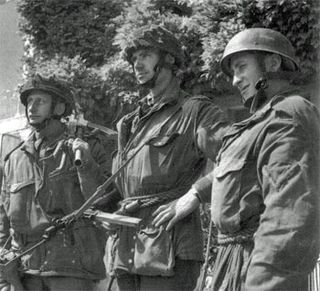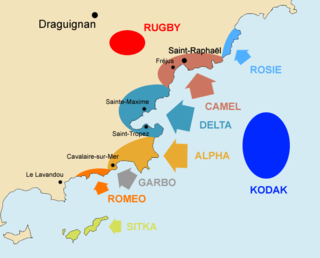
Operation Tonga was the codename given to the airborne operation undertaken by the British 6th Airborne Division between 5 June and 7 June 1944 as a part of Operation Overlord and the D-Day landings during World War II.

Operation Ladbroke was a glider landing by British airborne troops during the Second World War near Syracuse, Sicily, that began on 9 July 1943 as part of Operation Husky, the Allied invasion of Sicily. The first Allied mission using large numbers of the aircraft, the operation was carried out from Tunisia by glider infantry of the British 1st Airlanding Brigade, commanded by Brigadier Philip Hicks, with a force of 136 Waco Hadrians and eight Airspeed Horsas. The objective was to establish a large invasion force on the ground near the town of Syracuse, secure the Ponte Grande Bridge and ultimately take control of the city itself with its strategically vital docks, as a prelude to the full-scale invasion of Sicily.

The 1st Airborne Division was an airborne infantry division of the British Army during the Second World War. The division was formed in late 1941 during the Second World War, after the British Prime Minister, Winston Churchill, demanded an airborne force, and was initially under command of Major-General Frederick A. M. Browning. The division was one of two airborne divisions raised by the British Army during the war, with the other being the 6th Airborne Division, created in May 1943, using former units of the 1st Airborne Division.

The 6th Airborne Division was an airborne infantry division of the British Army during the Second World War. Despite its name, the 6th was actually the second of two airborne divisions raised by the British Army during the war, the other being the 1st Airborne Division. The 6th Airborne Division was formed in the Second World War, in mid-1943, and was commanded by Major-General Richard N. Gale. The division consisted of the 3rd and 5th Parachute Brigades along with the 6th Airlanding Brigade and supporting units.

The 5th Parachute Brigade was an airborne forces formation of brigade strength, raised by the British Army during the Second World War. Created during 1943, the brigade was assigned to the 6th Airborne Division, serving alongside the 3rd Parachute Brigade and the 6th Airlanding Brigade.

The 1st Parachute Brigade was an airborne forces brigade formed by the British Army during the Second World War. As its name indicates, the unit was the first parachute infantry brigade formation in the British Army.

The 2nd Parachute Brigade was an airborne forces brigade formed by the British Army during the Second World War.

The 3rd Parachute Brigade was an airborne forces brigade raised by the British Army during the Second World War. The brigade was initially part of the 1st Airborne Division, but remained in Britain when that division was sent overseas, and became part of the 6th Airborne Division, alongside 5th Parachute Brigade and 6th Airlanding Brigade.

The 1st Airlanding Brigade was an airborne infantry brigade of the British Army during the Second World War and the only glider infantry formation assigned to the 1st Airborne Division, serving alongside the 1st Parachute Brigade and 4th Parachute Brigade.

The 6th Airlanding Brigade was an airborne infantry brigade of the British Army during the Second World War. Created during May 1943, the brigade was composed of three glider infantry battalions and supporting units, and was assigned to the 6th Airborne Division, alongside the 3rd and 5th Parachute Brigades.

The British 2nd Parachute Brigade was part of the Operation Rugby airborne landings in August 1944. The operation was carried out by an ad hoc airborne formation called the 1st Airborne Task Force. Operation Rugby was itself part of the Operation Dragoon invasion of Southern France by the American 7th Army. The airborne task force landed in the River Argens valley with the objective of preventing German reinforcements from reaching the landing beaches. The landings were mainly an American operation and the brigade was the only British Army formation involved.

The 6th Airborne Division advance to the River Seine occurred in August 1944, in the later stages of the Battle of Normandy, following the German Army's defeat in the Falaise Pocket, during the Second World War.

The 7th Parachute Battalion was an airborne infantry battalion of the Parachute Regiment, formed by the British Army during the Second World War. The battalion was raised in November 1942 by the conversion of the 10th Battalion, Somerset Light Infantry to parachute duties. It was initially assigned to the 3rd Parachute Brigade, part of 1st Airborne Division, but moved to the 5th Parachute Brigade, alongside the 12th and 13th Parachute battalions, of the 6th Airborne Division soon afterwards.

The 11th Parachute Battalion was an airborne infantry battalion of the Parachute Regiment, raised by the British Army in World War II.

The 9th Parachute Battalion was an airborne infantry battalion of the Parachute Regiment, raised by the British Army during the Second World War. The battalion was created in late 1942 by the conversion of the 10th Battalion, Essex Regiment to parachute duties. The battalion was assigned to the 3rd Parachute Brigade, alongside the 7th and 8th Parachute battalions, then part of the 1st Airborne Division but was later transferred to the 6th Airborne Division.

The 10th Battalion, The Parachute Regiment was an airborne infantry battalion of the Parachute Regiment, originally raised as 10th (Sussex) Battalion by the British Army during the Second World War.

The 6th Parachute Battalion was an airborne infantry battalion of the Parachute Regiment raised by the British Army during the Second World War.

The 1st Airlanding Light Regiment was an airborne forces unit of the British Army's Royal Artillery during the Second World War.












